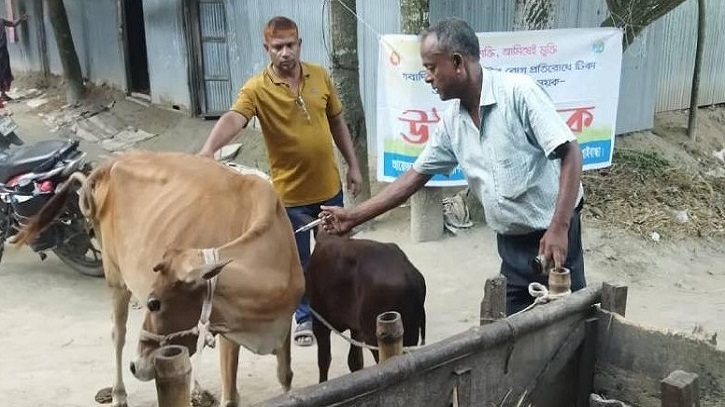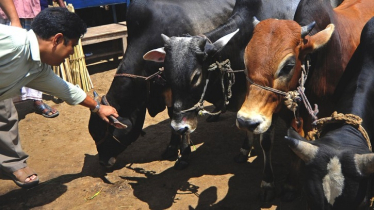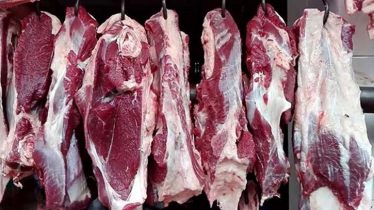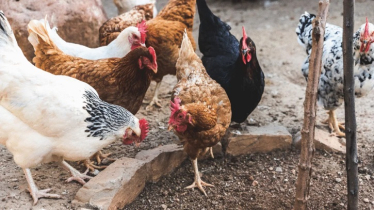
Over the past two months, more than 200 cattle have died from anthrax in Rangpur, while at least 50 people have been infected with the animal-borne disease. Health experts say that the outbreak is largely driven by public unawareness and unsafe handling of infected livestock. The disease has now spread to Pirgachha, Mithapukur, and Kaunia upazilas, where both vaccines for livestock and antibiotics for humans are reportedly in short supply—though health officials deny any scarcity.
According to the Office of the Civil Surgeon in Rangpur, 11 anthrax cases have been officially confirmed in the district. Between July and September, two people in Pirgachha died showing anthrax symptoms, and more than 50 others in the upazila displayed similar signs. Laboratory tests by the Department of Livestock Services confirmed anthrax in samples collected from diseased cattle. Later, a team from the Institute of Epidemiology, Disease Control and Research (IEDCR) visited the affected Pirgachha Sadar and Parul unions on September 13 and 14, collecting samples from 12 men and women showing symptoms. Eight of those cases were confirmed as anthrax.
Health officials report that the number of infections in Pirgachha, Mithapukur, and Kaunia has exceeded 50, although the IEDCR’s count remains at 11. Local sources have confirmed that vaccines for livestock and antibiotics for patients are running low.
In Mithapukur, an incident in Amaipur village of Imadpur union triggered new infections around 20 days ago. A sick cow was slaughtered, and several villagers who handled the meat later developed skin lesions characteristic of anthrax. Samples from the patients were sent to IEDCR, where one case was confirmed.
Dr. M. A. Halim Lablu, the medical officer (disease control) at Mithapukur Upazila Health Complex, said that 11 people—seven men and four women—showed symptoms of anthrax after coming into contact with the infected cow’s fluids and tissues. “The infection spreads from animals to humans through contact with infected blood, saliva, or meat, but it does not spread from human to human. People must avoid slaughtering or consuming diseased animals,” he said.
According to the District Livestock Department, more than 1.2 million cattle and goats live in the three affected upazilas, and around 30 percent are believed to have been infected. Two or more cattle are dying every day, with over 200 deaths recorded in just two months.
Pirgachha Upazila Livestock Officer Dr. Ekramul Haque said that “at least 150,000 animals have been infected in Pirgachha alone.” So far, 53,400 vaccine doses have been distributed, and a demand for an additional 50,000 has been submitted but not yet met. “This disease cannot be eradicated quickly. We are focusing on prevention through vaccination and public awareness. Medical teams are active in the field, and people are being advised not to consume beef,” he added.
In Mithapukur and Kaunia, officials confirmed that 20,000 vaccine doses were provided against a total demand of 80,000. All available doses have already been used, leaving no vaccines currently in stock.
Mithapukur Livestock Officer Dr. Altaf Hossain said, “There is no alternative to raising public awareness. We are vaccinating infected livestock as much as possible, though there is a shortage.”
Officials also revealed that the outbreak began in July when a farmer in Mital area of Pirgachha slaughtered an infected cow and later died after developing anthrax. In the same upazila, a homemaker named Komola Begum died on September 6 after washing and cooking meat from the same cow. Other villagers who helped with the slaughter and cooking also developed symptoms, leading to the spread of the infection across several areas.
A livestock officer, speaking on condition of anonymity, said that early in the outbreak, farmers sold sick cattle cheaply, and villagers bought the meat at Tk 400–500 per kilogram. “The disease spread as villagers, especially women, handled and cooked the infected meat. Avoiding meat consumption is the only effective prevention method, as it’s difficult to distinguish between infected and healthy animals. Local authorities must tighten monitoring of cattle slaughtering in rural areas,” he added.
Pirgachha Upazila Nirbahi Officer Sheikh Md. Rasel said that a demand for 50,000 more vaccine doses has already been submitted. “The situation is under control for now, and patients are receiving treatment,” he said.
Rangpur Civil Surgeon Dr. Shahin Sultana stated that medical teams are working around the clock in the affected upazilas. “Residents have been advised not to slaughter infected cattle. The IEDCR has been informed, and we have provided treatment guidelines to all upazilas. There are adequate antibiotics in stock, and vaccines are being administered. If any shortages arise, we are supplying accordingly,” she said, adding that the exact number of cattle deaths is yet to be determined.
District Livestock Officer Abu Sayeed said that vaccination campaigns began in August immediately after anthrax was detected. “However, delays in human sample testing by the health department contributed to the rise in confirmed cases. We are now vaccinating in Pirgachha, Kaunia, Mithapukur, Rangpur Sadar, and neighboring upazilas of Gaibandha and Kurigram,” he added.





